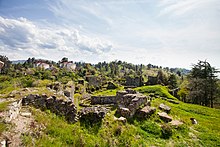Lazic War
Besides, it was protected by strong fortresses, including Petra, Archaeopolis, Sarapanis, Skande, Phasis, Rhodopolis, Uchimerion, Kotayon, Onoguris, Trachea, Sebastopolis and Pitius.
By that time, in order to foster their influence over the local monarchy, the Byzantines had insisted on the conversion of the king, Tzath I: he received both baptism and royal attributes in Constantinople from Emperor Justin I (Justinian's predecessor) in 522/3.
Those calls were answered that year by the Persian king Khosrow I, who entered Lazica, captured the Byzantine main stronghold of Petra, and established another protectorate over the country.
In 543, a Roman invasion of Armenia was defeated by a small Persian force at Anglon, and Khosrow I unsuccessfully besieged Edessa in Mesopotamia a year later.
Justinian sent 7,000 Roman and 1,000 Tzani (relatives of the Lazes) auxiliaries under Dagisthaeus to assist Gubazes and besieged the fortress of Petra but faced tough resistance from its heavily outnumbered garrison.
The new Byzantine commander Bessas quelled a pro-Persian revolt of the Abasgi tribe, took and dismantled the fort of Petra after a lengthy siege and fierce fighting as Mihr-Mihroe did not arrive in time.
In the autumn and winter of the same year, the Byzantines suppressed a rebellion staged by the mountain tribe of the Misimians, and finally made peace.
Although no clear winner emerged from the conflict, the Sasanian Empire thus held a slight advantage since Rome was required to pay a set amount to Persia annually.



